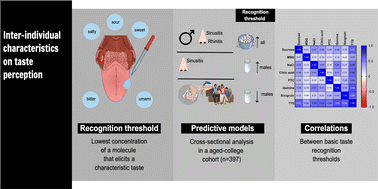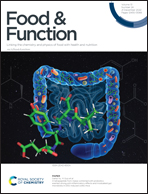Inter-individual characteristics on basic taste recognition thresholds in a college-aged cohort: potential predictive factors†
Abstract
Studying nutritional status from the perspective of taste sensitivity, rather than only dietary patterns, may provide new insights into the role of taste receptor signaling in the development of metabolic-associated diseases. In this cross-sectional study, we investigated the possible influence of sociodemographic (sex and smoking habit) and clinical variables (dental cavities, missing teeth, sinusitis, rhinitis, body mass index and metabolic high prevalence family antecedent diseases) on tastant (sucrose, monosodium glutamate, sodium chloride, citric acid, quinine, sinigrin, phenylthiocarbamide) recognition thresholds (RTs) in a college-aged cohort (n = 397). Predictive models for the tastant RTs were generated and a higher sucrose RT was found in females than in males, while sinusitis and rhinitis explained sucrose and sodium chloride RTs. Smoking habit was not an important predictive factor of taste sensitivity, although its long-term influence on RTs remains unclear. Additionally, a positive correlation was found between all the tastant RTs studied. Although results did not show a clear pattern, the statistical approach employed should prove useful in future studies of predictors of taste sensitivity.

- This article is part of the themed collection: 3rd International Conference on Food Bioactives & Health


 Please wait while we load your content...
Please wait while we load your content...